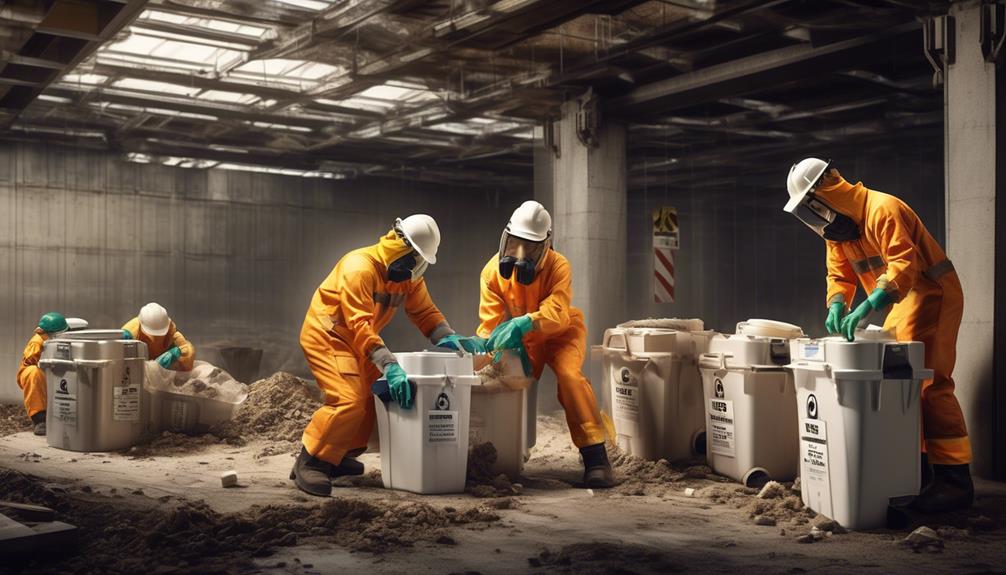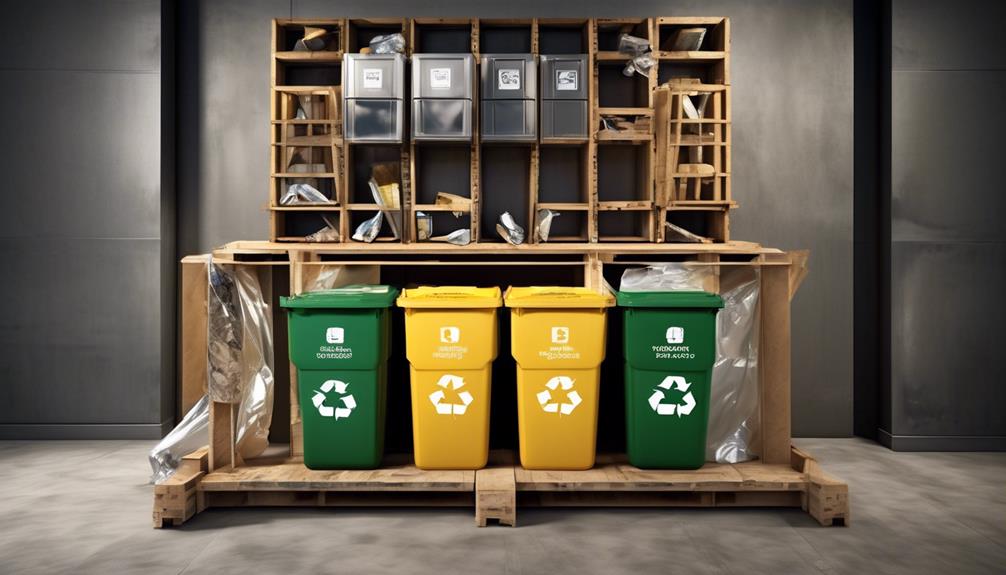In today’s society, with increasing focus on environmental issues, the construction industry is facing a critical moment. The choices we make today will shape the future for generations to come.
Ensuring environmental compliance in construction is not just a legal requirement but a fundamental responsibility that shapes the sustainability of our projects and contributes to the well-being of the planet.
It’s essential to understand the key strategies that can steer construction companies towards effective environmental compliance, from developing robust environmental management systems to overcoming communication challenges in implementing sustainability goals.
These strategies not only pave the way for regulatory adherence but also serve as a cornerstone for building a resilient and reputable construction industry.
Key Takeaways
- Environmental compliance is crucial in construction to protect the environment and promote sustainable practices.
- Compliance with regulations helps avoid legal issues and penalties.
- Developing an environmental compliance program requires defining policies, understanding regulatory requirements, and providing relevant training.
- Staff training should focus on environmental regulations, incident reporting, and hazardous materials management.
Importance of Environmental Compliance
We ensure environmental compliance to protect the environment and promote sustainable work practices, adhering to local and federal regulations and minimizing negative impacts on ecosystems and habitats.
Environmental compliance in construction is of paramount importance as it not only ensures adherence to regulations, avoiding potential legal issues and penalties, but also promotes responsible and sustainable work practices. By complying with environmental regulations, we contribute to environmental protection and conservation, playing a crucial role in safeguarding the natural world.
Moreover, our commitment to compliance mitigates potential health risks for workers and inhabitants, creating a safe working environment. This dedication to environmental compliance also extends to protecting the environment and wildlife, minimizing negative impacts on ecosystems and habitats, thereby preserving biodiversity.
Additionally, our focus on compliance guides long-term management and planning, ensuring sustainable development and effective resource management. Through our meticulous attention to detail and regulatory knowledge, we integrate compliance with environmental regulations seamlessly into our project management, fostering sustainable construction practices and contributing to the greater good of environmental protection.
Types of Environmental Compliance

Transitioning from the importance of environmental compliance, the types of environmental compliance in construction encompass various aspects of managing and mitigating potential impacts on the environment. It is crucial for construction projects to adhere to regulations and best practices to ensure sustainability and minimize environmental impact. Environmental compliance involves several key areas, including water, air, spill, hazardous materials, and acute hazardous waste compliance.
| Types of Environmental Compliance | Description |
|---|---|
| Water Compliance | Involves stormwater management, permits, and inspections. |
| Air Compliance | Focuses on limiting VOCs and HAPs, and obtaining air permits. |
| Spill Compliance | Requires a SPCC plan, EPA notification, and spill containment. |
| Hazardous Materials Compliance | Involves managing EPA ID numbers, waste accumulation, and reporting. |
| Acute Hazardous Waste Compliance | Imposes stringent requirements for large quantity generators. |
Each of these areas requires meticulous attention to detail and precise project management to ensure compliance with environmental impact assessments and regulations. By integrating these types of environmental compliance into construction projects, it is possible to achieve sustainable and environmentally responsible outcomes while meeting legal requirements.
Developing an Environmental Compliance Program
Now, let’s focus on the crucial steps for developing an effective environmental compliance program.
We’ll need to carefully outline the specific program development steps, ensuring that every aspect is thoroughly considered.
It’s essential to provide a detailed overview of the regulatory requirements and standards that must be met.
Then, we’ll dive into the essentials of staff training for environmental compliance.
Program Development Steps
How can we establish an environmental policy to guide the development of our environmental compliance program?
To develop an effective environmental compliance program in the construction industry, project managers need to follow key program development steps:
- Define an environmental policy to guide program development.
- Develop a strategy for organizational structure, planning, and support.
- Minimize environmental impact and identify risks through continuous improvement.
Regulatory Requirements Overview
To ensure the successful development of our environmental compliance program in construction, it is crucial to thoroughly understand and adhere to local and federal regulatory requirements. Compliance with environmental regulations is essential for construction companies to mitigate risks and promote sustainable practices. Key regulatory requirements include stormwater management, air permit compliance, spills prevention, and hazardous materials management. Establishing an environmental policy and providing relevant training within the construction organization are vital steps. Effective communication ensures that all stakeholders are aligned with sustainability goals and regulatory requirements. Developing reporting systems and contingency plans further strengthens environmental compliance efforts. Adhering to these regulatory requirements not only minimizes environmental impact but also enhances the overall reputation and performance of construction projects.
| Regulatory Requirements | Overview |
|---|---|
| Stormwater Management | Ensure compliance with regulations for controlling stormwater runoff. |
| Air Permit Compliance | Adhere to air quality standards and obtain necessary permits for construction activities. |
| Spills Prevention | Implement measures to prevent and manage spills of hazardous substances. |
| Hazardous Materials Management | Proper handling, storage, and disposal of hazardous materials in compliance with regulations. |
Staff Training Essentials
Developing a comprehensive staff training program is essential for ensuring environmental compliance in construction and promoting sustainable practices. When considering training and education for construction teams, a focus on environmental regulations, compliance, and environmental standards is crucial.
Additionally, an effective communication plan is essential for ensuring that the entire team is aware of environmental monitoring practices and reporting incidents. Training should cover a wide range of topics, including hazardous materials management, spill response, and recycling, to ensure that staff are well-prepared to handle various environmental scenarios.
Seven Key Steps for Sustainability Goals

Integrating sustainability into project planning enhances compliance with environmental regulations and demonstrates commitment to responsible construction practices. To achieve sustainability goals, construction projects must prioritize a set of key steps.
Firstly, it’s essential to prioritize sustainable practices in all aspects of the project, from material sourcing to waste management. Compliance with environmental regulations should be a foundational principle, ensuring that all actions align with legal requirements and industry standards. Regular inspections and monitoring and reporting mechanisms are vital to ensure that environmental considerations are consistently upheld throughout the project lifecycle.
Moreover, the adoption of energy-efficient technologies and designs is crucial for minimizing the environmental impact of construction activities. Additionally, engaging with green building certification programs, such as LEED, can provide a structured approach to meeting high sustainability standards. Lastly, a commitment to working with suppliers that also prioritize sustainability practices is paramount, ensuring that materials and equipment used in the project align with sustainability goals.
Environmental Management System

Implementing an Environmental Management System (EMS) is crucial for construction projects to effectively manage their environmental responsibilities and minimize their impact on the environment. An EMS provides a structured approach to integrating sustainable practices into project management, ensuring compliance with environmental regulations, and reducing the use of hazardous materials.
Key components of an EMS include identifying environmental aspects, setting objectives for improvement, and establishing procedures for monitoring and measuring environmental performance. Certification to international standards such as ISO 14001 demonstrates a commitment to environmental management, enhancing the credibility of construction projects in terms of their environmental impact.
- An EMS provides a framework for managing environmental responsibilities.
- It involves planning, implementing, and monitoring policies and procedures.
- EMS promotes continual improvement in environmental performance.
Environmental Protection Training Program

As we continue our focus on environmental compliance in construction, the next vital aspect to address is the Environmental Protection Training Program, which plays a crucial role in educating and aligning employees with sustainability goals and regulatory requirements.
This training program is designed to provide a comprehensive understanding of environmental regulations, the environmental impact of construction activities, and the proper handling of construction materials. It educates employees on how to recognize and respond to potential environmental situations, aligning them towards sustainability goals and the prevention of accidents that may harm the environment.
The program emphasizes the importance of reporting incidents of noncompliance and responding accordingly, ensuring that the workforce is well-equipped to uphold environmental compliance standards.
Additionally, the training program also serves as a platform for integrating environmental considerations into project management, ensuring that environmental protection becomes an integral part of the construction process.
Hazardous Materials Management

We develop a comprehensive hazardous materials management plan to ensure the proper handling, storage, and disposal of hazardous materials at the construction site.
This plan encompasses identifying and inventorying hazardous materials, as well as providing safety data sheets and procedures for their safe handling and storage.
Additionally, we offer hazardous materials training to all personnel involved in the project and implement a Spill Prevention, Control, and Countermeasure (SPCC) plan to mitigate potential environmental impact.
Proper hazardous materials management is essential for environmental compliance in construction projects.
It involves adhering to stringent environmental regulations, ensuring the safety of workers and the public, and minimizing the project’s environmental impact.
Our approach to hazardous materials management integrates seamlessly with project management, as we prioritize sustainable practices and compliance with environmental regulations.
Environmental Communication Plan

To effectively minimize our environmental footprint and ensure compliance with regulatory standards, the development of a comprehensive environmental communication plan is imperative in our construction projects. This plan serves as a foundational element in our environmental compliance strategy, facilitating streamlined communication efforts and ensuring that all stakeholders are well-informed and engaged in sustainable practices. By providing accessible training on environmental communication, we can enhance the reception and understanding of crucial environmental policies and regulations. The table below outlines key components of an effective environmental communication plan, emphasizing its role in maintaining a reduced environmental footprint and effectively conveying sustainability goals.
| Key Components of Environmental Communication Plan |
|---|
| Streamlined communication efforts |
| Accessible training for stakeholders |
| Engagement in sustainable practices |
| Reception and understanding of environmental policies |
| Conveyance of sustainability goals |
Implementing a robust environmental communication plan not only ensures compliance with environmental regulations but also aligns with efficient project management, ultimately contributing to the overall success of our construction endeavors.
Recycling Plan

Upon establishing a robust environmental communication plan to facilitate streamlined communication efforts and ensure stakeholder engagement in sustainable practices, we now turn our focus to developing a comprehensive recycling plan to minimize waste and promote sustainability in our construction projects.
Our recycling plan aims to address the environmental impact of construction activities and materials by implementing specific goals to minimize waste. To support recycling efforts, we’ll incorporate green products and materials during design and construction, promoting a circular economy within our projects. Additionally, we’ll prioritize the reuse of construction materials in building projects to reduce waste and promote sustainability.
By effectively implementing recycling strategies, we aim to maximize benefits and profits while adhering to environmental regulations and ensuring a comprehensive and effective recycling plan.
This approach won’t only mitigate the environmental impact of our construction projects but also demonstrate our commitment to environmental compliance and responsible construction practices.
Environmental Compliance Mitigation

As we continue our exploration of environmental compliance in construction, it’s crucial to focus on the key points of permitting requirements, waste management plans, and pollution prevention measures.
These aspects play a vital role in ensuring that our construction activities align with environmental regulations and standards.
Permitting Requirements
In ensuring environmental compliance for construction projects, there are several key steps that need to be taken.
Firstly, obtaining the necessary permits and inspections for construction activities is essential to comply with stormwater management regulations. This involves meeting specific requirements and guidelines set by regulatory authorities.
Another important aspect of compliance is managing and limiting the release of Volatile Organic Compounds (VOCs) and Hazardous Air Pollutants (HAPs). This can be achieved through permits and planning, which ensure air compliance.
Additionally, it is crucial to develop and implement a Spill Prevention, Control, and Countermeasure (SPCC) plan. This plan includes EPA notification and containment procedures to address spills effectively and comply with spill regulations.
Furthermore, establishing an environmental management plan is necessary to minimize environmental impact, identify risks, promote awareness, and ensure continuous improvement. This plan should outline strategies and actions to be taken throughout the construction project to ensure compliance and sustainability.
Collaboration with regulatory authorities and stakeholders is also essential. This collaboration helps meet reporting requirements and ensures that all parties are working together towards sustainable construction practices.
Lastly, addressing hazardous materials through a comprehensive management plan and providing training to workers is imperative for compliance. This helps mitigate risks and ensures that all employees are aware of the proper handling and disposal procedures for hazardous materials.
Waste Management Plans
Developing a comprehensive waste management plan is crucial for effectively mitigating environmental compliance challenges in construction projects. By implementing sustainable practices, such as waste segregation, recycling, and proper disposal of hazardous materials, construction companies can significantly reduce their environmental impact.
This involves not only the responsible disposal of waste but also the reusing of materials wherever possible. To achieve this, it’s essential to educate and train the workforce on waste management procedures and best practices.
Additionally, regular monitoring and evaluation of waste management processes are necessary to ensure compliance with environmental regulations and to drive continuous improvement. Efficient material use and construction practices also play a crucial role in minimizing waste generation.
Pollution Prevention Measures
Effective pollution prevention measures are essential for minimizing the environmental impact of construction activities. Building upon the foundation of comprehensive waste management plans, we must adhere to environmental regulations and implement pollution prevention measures. This includes training employees on pollution prevention techniques, developing a hazardous materials management plan, and promoting awareness among all project stakeholders.
Construction Monitoring

Regularly monitoring construction activities is essential to ensure strict adherence to environmental regulations and standards. By implementing real-time monitoring systems for air and water quality, we can promptly address any environmental impact.
Routine inspections play a crucial role in identifying and mitigating potential environmental risks. Utilizing remote monitoring technology allows us to track environmental impacts and compliance, providing us with valuable data for making informed decisions.
Collaborating with environmental agencies is vital to establishing monitoring protocols and best practices, ensuring that our construction activities are in line with sustainable practices. Open communication with all stakeholders is key to successfully integrating construction monitoring into our environmental compliance strategy.
Overcoming Communication Challenges

To enhance communication and collaboration, we streamline technical language for better comprehension and foster partnerships across sectors.
Overcoming communication challenges in construction projects is vital for ensuring environmental responsibility and sustainability. It requires a proactive approach to address the complexities of environmental regulations and the extensive impact of construction activities on the environment.
To achieve this, we employ the following strategies:
- Establish Clear Communication Channels: Creating centralized online platforms and regular meetings facilitate effective communication among project stakeholders, enabling the dissemination of crucial environmental compliance information.
- Simplify Regulatory Materials: Translating environmental regulations and technical documents into relevant languages ensures that all team members, regardless of their linguistic background, comprehend the environmental requirements and responsibilities.
- Encourage Public Engagement: Engaging in consultations and awareness campaigns with the local community enhances public understanding of the environmental impact of construction, fostering support and cooperation for sustainable construction practices.
Frequently Asked Questions
What Is the Environmental Compliance Strategy?
We understand the importance of environmental compliance strategy in construction. It involves meticulous planning, regulatory adherence, and proactive measures to minimize environmental impact.
Our approach integrates thorough assessments, robust policies, and effective communication. We prioritize compliance with local and federal regulations, emphasizing responsible waste management, energy efficiency, and sustainable practices.
Our commitment to environmental compliance ensures the protection of workers, inhabitants, and the environment, guiding our long-term management and planning.
What Are Environmental Compliance Procedures?
We implement environmental compliance procedures to ensure adherence to regulations, promote sustainable practices, and avoid health risks.
This involves monitoring, reporting, and mitigating potential environmental impacts. We prioritize training, regular audits, and clear communication to maintain compliance.
Our proactive approach includes thorough planning and risk assessments. We work closely with regulatory bodies, stakeholders, and environmental experts to continually improve our procedures and minimize our environmental footprint.
What Are the Types of Environmental Compliance?
In water compliance, we manage stormwater, obtain permits, and conduct site inspections.
Air compliance entails limiting VOCs and HAPs, obtaining air permits, and considering indoor air quality.
Spill compliance involves creating an SPCC plan, notifying the EPA, and handling spills responsibly.
Hazardous materials management requires developing a plan, proper handling, training, and inventory.
Environmental communication includes policies, stakeholder training, and reducing environmental impact.
How Do You Mitigate Environmental Risk in a Construction Project?
Mitigating environmental risk in construction involves thorough planning, integrating environmental considerations, providing worker training, optimizing logistics, and fostering community collaboration. This ensures compliance with regulations and minimizes negative impacts on the environment.
Identifying and addressing potential hazards is crucial for successful risk management. By incorporating these strategies, we can effectively mitigate environmental risk in construction projects, demonstrating our commitment to environmental stewardship and regulatory compliance.
Conclusion
In conclusion, embracing environmental compliance in construction isn’t just a regulatory requirement, but a strategic choice for the future of the industry.
By implementing sustainability goals, environmental management systems, and effective communication, construction companies can’t only meet regulations, but also contribute to a more sustainable and resilient future.
Just like a sturdy foundation supports a building, environmental compliance supports the future well-being of our planet and generations to come.
Randy serves as our Software Quality Assurance Expert, bringing to the table a rich tapestry of industry experiences gathered over 15 years with various renowned tech companies. His deep understanding of the intricate aspects and the evolving challenges in SQA is unparalleled. At EarnQA, Randy’s contributions extend well beyond developing courses; he is a mentor to students and a leader of webinars, sharing valuable insights and hands-on experiences that greatly enhance our educational programs.










